Automatic Storage-Retrival Systems
high-bay warehouse
Automatic storage and retrieval machines
Automatic high-bay warehouses are loaded and unloaded by storage and retrieval machines (SRMs) controlled by complex automation systems. For these applications, the WinMOD-SIMLINE system offers a comprehensive 3D library with typical RLG variants that can be flexibly parameterised in terms of their dimensions. This allows both unit load RLGs for single or double-depth pallet and container storage and highly dynamic mini-load RLGs for small load carriers, cartons or trays to be implemented.
The travel paths of the RBG are created using configurable 3D floor rail elements such as straight lines, curves and switches. This allows you to virtually realise any given rail layout, including lane changes. There are also 3D library elements for the many different load handling devices such as telescopic forks, grippers or, in the case of channel storage systems, satellite and shuttle systems.


High-bay warehouse with warehouse management system
3D shelf elements with a dynamically adjustable number of levels and compartments are available for fast and efficient mapping of the storage area. These are stocked with virtual 3D storage goods, which receive individual information directly from the real warehouse management system.
This also allows virtual commissioning (VC) of complex control and warehouse management systems to be carried out completely and realistically. Operating strategies, such as single or dual command for route and strategy optimisation, as well as tracking via barcode or RFID, can be tested in a targeted manner.
Since such systems usually consist of several automation units, WinMOD enables the simultaneous connection of multiple controllers via different fieldbus architectures – for comprehensive, parallel simulation and commissioning.
Further factory automation solutions
Sorting and picking systems for small items such as cartons, plastic boxes or other piece goods. Transport is via classic roller conveyors, belt conveyors
as well as the typical cam roller conveyors found here,
Belt curves and accumulation roller conveyors.
This area of technology encompasses conveyor systems that transport and sort pallets and mesh boxes. The conveyor elements are large roller and chain conveyors combined with lifting, rotating and shifting tables. Magazines for empty pallets are also typical here.
These systems are usually fully automated high-bay warehouses that are operated by storage and retrieval machines and controlled by distributed automation systems. Warehouse management systems generate the orders for storage and retrieval.
Automated systems that pick up parts from A to B and place them down again with a defined orientation – typically for loading, sorting, picking or packing. Core systems are industrial robots (Delta, SCARA, 6 axes, Cartesian) or gantry axes.
Robotics plays a central role in modern manufacturing by enabling the automation of production processes and increasing efficiency and precision. Robots are used in various areas, such as welding, assembly, painting or packaging products.
Production lines combine processes, material flow and controls into a production system with guaranteed cycle times and quality. They consist of combinations of assembly, processing and testing stations. In addition, there is transfer technology, buffers and often a highly specialised automation system.
Electric Monorail Systems are used as connecting conveyor technology over long distances. The overhead trolleys run fully automatically with integrated electric drives and controls and are usually routed via a central control system.
This chain-driven overhead or floor conveyor technology is powered by continuously running power strands (chains). Transport trolleys are coupled in, transported, decoupled at stoppers and buffered via chain drivers („dogs“).
Automated self-driving vehicles as a connecting material flow solution. Driving is either completely trackless via defined tracks or markers (AGV) or via free navigation with automatic dynamic obstacle avoidance (AMR).
Engineering discipline for the development, manufacture and maintenance of machines, plants and production systems. Typical applications include machine tools, handling technology, automotive/aerospace, packaging and assembly plants.